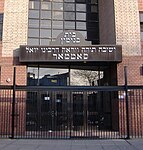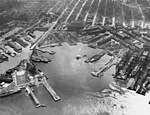Congregation Yetev Lev D'Satmar (Hooper Street, Brooklyn)
2006 establishments in New York CityHasidic Judaism in New York CityHasidic synagoguesJewish organizations established in 2006Orthodox synagogues in New York City ... and 4 more
Satmar (Hasidic dynasty)Synagogues completed in 2006Synagogues in BrooklynWilliamsburg, Brooklyn

Congregation Yetev Lev D'Satmar is a large Hasidic synagogue located at Kent Avenue and Hooper Street in Williamsburg, Brooklyn. Its building was constructed in 2006 by followers of Aaron Teitelbaum, as a result of a feud with followers of Zalman Teitelbaum (both sons of the deceased Satmar rebbe Moshe Teitelbaum). It has been dubbed the "miracle synagogue" because it was constructed in just 14 business days.
Excerpt from the Wikipedia article Congregation Yetev Lev D'Satmar (Hooper Street, Brooklyn) (License: CC BY-SA 3.0, Authors, Images).Congregation Yetev Lev D'Satmar (Hooper Street, Brooklyn)
Hooper Street, New York Brooklyn
Geographical coordinates (GPS) Address Nearby Places Show on map
Geographical coordinates (GPS)
| Latitude | Longitude |
|---|---|
| N 40.701030555556 ° | E -73.963147222222 ° |
Address
Hooper Street
Hooper Street
11211 New York, Brooklyn
New York, United States
Open on Google Maps









